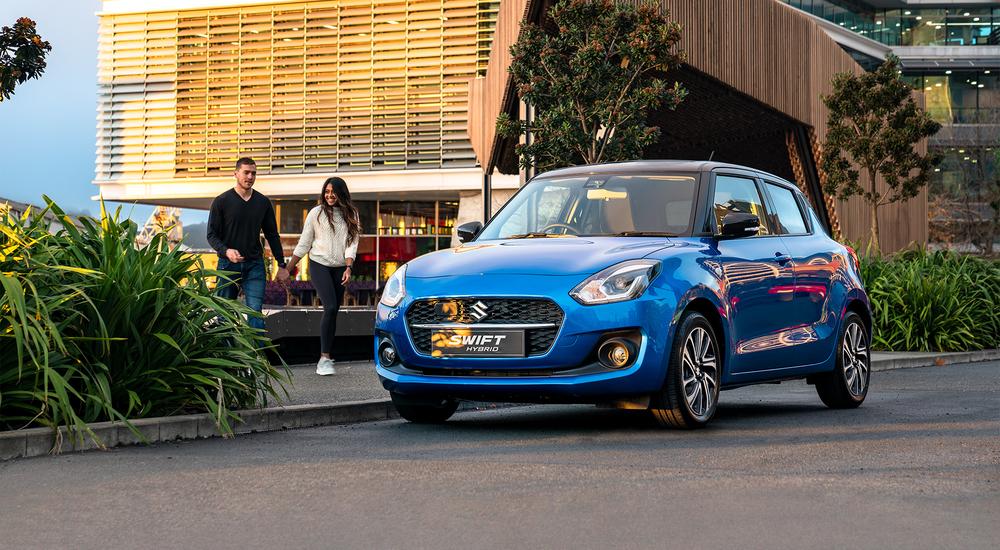13 Oct 2022
New Swift RS Hybrid Joins the Suzuki Lineup in New Zealand

A new highly specified mild hybrid version of the thrifty, low emission Suzuki Swift CVT automatic that goes further on every tankful of petrol has arrived in New Zealand.
The RS Smart Hybrid Swift uses the same 1,197 cm3 displacement K12D four-cylinder engine as the highly affordable Swift Hybrid GLX which remains in the local lineup while adding a comprehensive standard level of specification.
According to the official combined fuel consumption test, the Swift Hybrid’s 4.1 litres/100km (68.9 miles per gallon) average result means this economical five door hatchback is capable of travelling around 900 kilometres on a full tank of fuel – over 100 kilometres more than the 1.2 litre Swift GL model. Compared to all new models in New Zealand’s light car segment the Swift Hybrid is 17 per cent more economical.
The RS Hybrid comes fully equipped with the added safety of Suzuki’s advanced forward detection system and higher comfort levels. The Swift benefits from AEB, lane keep function, lane departure warning, weaving alert and blind spot monitor. There is also rear cross traffic alert that warns drivers of an unseen vehicle while reversing and rear parking proximity sensors, keyless entry, push button start, and tilt/telescopic adjustment for the steering wheel.
Braking is upgraded with discs brakes all round and dual sensor brake support comprising a monocular camera that “sees” mid-to-long distance and can detect pedestrians. Once the RS Hybrid is travelling at 40 km/h or faster the headlight high beam assist automatically switches the headlights between high and low beam depending on the presence of other vehicles and the lighting environment.
An upgraded level of standard specification includes door mirrors equipped with built-in signal lamps, electrically folding exterior mirrors, climate control air conditioning, steering wheel mounted paddle shifters and central dashboard detailing in silver. Warnings are provided for the hybrid battery status, tyre pressures and oil change reminders.
Suzuki pioneered the Smart Hybrid Vehicle system (SHVS) in 2016. It is a self-charging hybrid featuring a specially developed power unit assisted by a compact, high performing 12-volt lithium-ion battery that only adds 25 kg to the car’s curb weight. This mild hybrid uses a motor to support fuel-consuming standing starts and acceleration and with the automatic stop-start the petrol motor is shut down when the car is stationary in traffic or stopped at other times while the vehicle is in use.
SHVS combines a belt-driven integrated starter generator (ISG) and the 10Ah lithium-ion battery with the ISG acts as both a generator and starter motor. Besides assisting the engine with an efficient regeneration rate, the compact lithium-ion battery also powers various electrical parts, including engine electronics, the speedometer and the audio unit.
During deceleration the system checks the charge status of both the lead-acid battery and lithium-ion battery and recharges the batteries as needed. When battery charge is sufficient, instead of generating electricity, engine power is solely used for driving.
The compact SHVS system achieves better fuel economy without compromising interior space or usability.
Five of the seven versions of the highly popular Swift model available in New Zealand qualify for the Clean Car Rebate. The Hybrid RS has a recommended retail price of $30,990 and as the car produces remarkably low average emission levels of 94 grams/km - an improvement of 23 percent - it benefits from the highest claim rebate of $3,160.52 in the range of Suzuki models.
Backed with a 5 Star ANCAP safety rating, the Automobile Association has just named the Swift Hybrid GLX one of the top five best selling petrol-hybrid passenger cars in New Zealand so far this year. The AA said Swift owners were among the most satisfied in the small car category according to Consumer NZ surveys.
Year to date sales of all new Suzuki Swifts in New Zealand have increased by 14 percent matched to the same period in 2021 compared to an increase of just 4.5 percent for total passenger and SUV new vehicle registrations during the same time.
